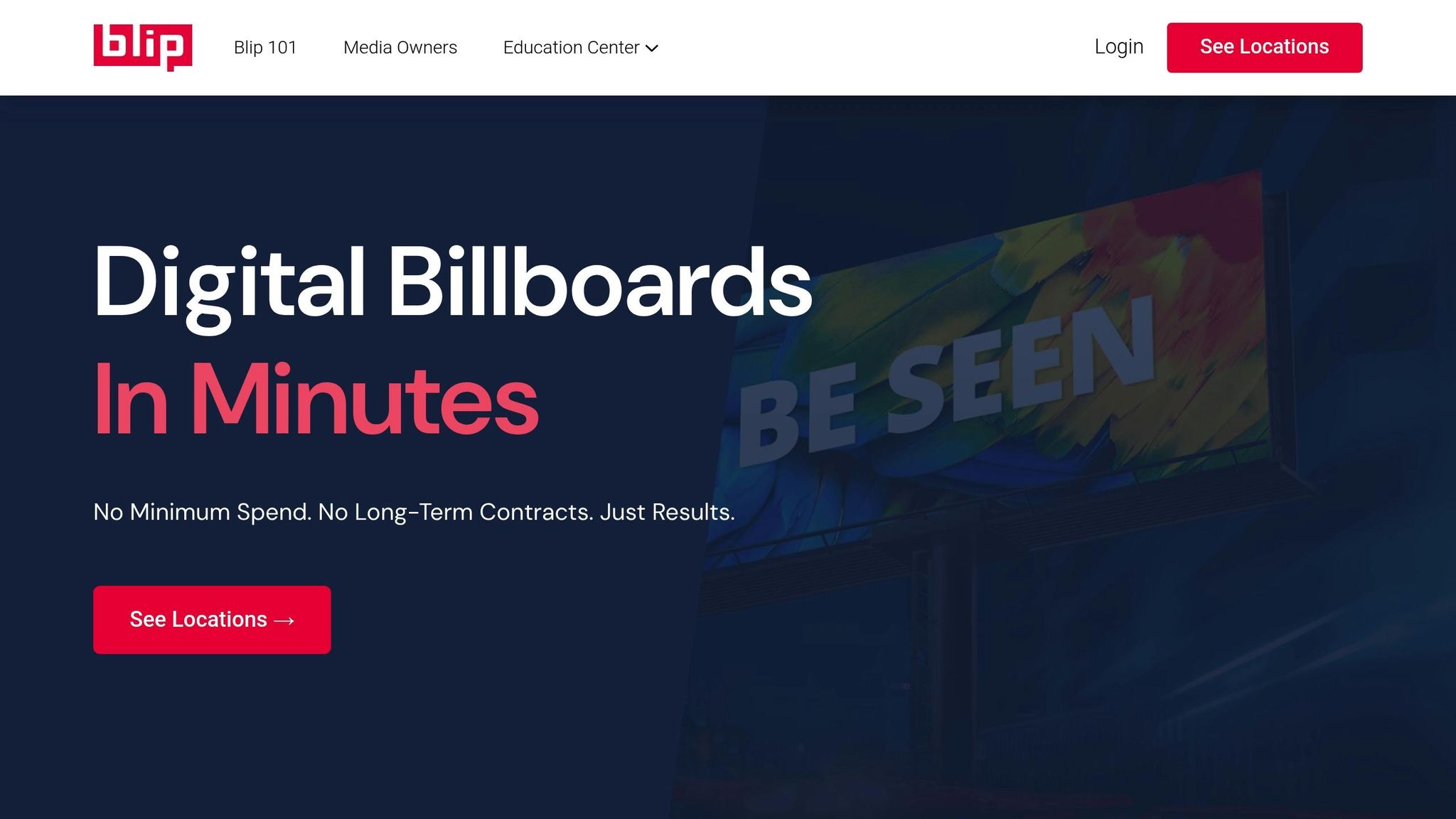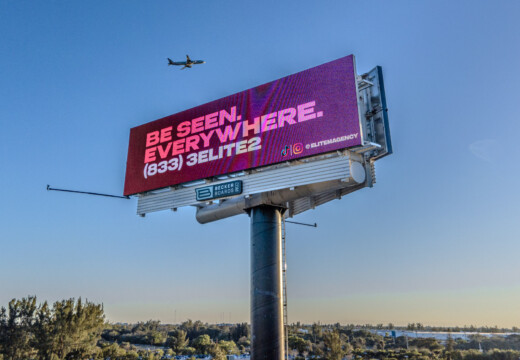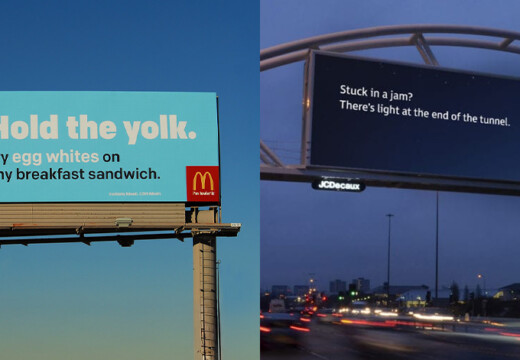AI is transforming billboard advertising. In 2025, it’s all about using real-time data and machine learning to deliver highly relevant ads. Here’s how AI is changing the game:
- Predictive Analytics: AI forecasts campaign success, improving ad timing and placement.
- Real-Time Adjustments: Ads adapt instantly based on audience feedback and conditions like traffic or weather.
- Advanced Segmentation: Combines data (location, demographics, behavior) to create precise audience profiles.
- Dynamic Personalization: Tailors ads in real-time using live data like local events or mobile signals.
- Ethical Targeting: Prioritizes privacy and fairness while eliminating bias.
AI tools like Blip also offer performance-based pricing, geofencing, and weather-responsive displays to maximize ad impact while staying cost-effective. This revolution makes billboard advertising smarter, faster, and more relevant than ever.
The AI Revolution in DOOH: How Street-Level Advertising Is Being Transformed in 2025 🚗💡
Predictive Analytics in Ad Targeting
Predictive analytics has transformed billboard advertising from static displays into dynamic, data-driven campaigns. By processing massive amounts of real-time data, AI systems enable more precise targeting and boost campaign performance. These advancements build upon earlier AI innovations, making ad campaigns sharper and more effective.
Advanced Audience Segmentation
AI combines multiple data sources to create detailed audience profiles, which enhance targeting precision. Here’s how it works:
| Data Type | Insights Generated | Targeting Impact |
|---|---|---|
| Location Data | Traffic patterns, popular routes | Best timing for billboard displays |
| Demographic Info | Age groups, income levels | Tailored messaging |
| Behavioral Signals | Purchase history, online activity | More relevant content |
| Contextual Factors | Weather, local events | Real-time message adjustments |
The real power of AI-driven segmentation lies in its ability to spot subtle patterns that human analysis might miss. For instance, in busy urban areas, AI can detect recurring travel behaviors, allowing advertisers to time their messages for maximum visibility and impact.
Looking ahead, experts anticipate that by 2025, deeper integration of AI with IoT devices will lead to richer data collection and hyper-local targeting, pushing audience segmentation to a whole new level.
Real-Time Campaign Optimization
With detailed audience insights in hand, AI fine-tunes campaigns in real time to maximize effectiveness:
- Timing Optimization: AI evaluates traffic flows and engagement metrics to schedule ads during peak visibility times.
- Content Refinement: Predictive models identify which creative elements resonate most and adjust content dynamically.
- Budget Allocation: By analyzing performance across locations and times, AI reallocates ad spend to the best-performing combinations.
These real-time adjustments ensure campaigns remain agile and responsive, delivering better results almost instantly.
Moreover, predictive tools combine historical performance data with current trends to offer actionable insights for refining campaigns. This data-driven approach removes much of the guesswork, ensuring that advertising budgets are directed toward strategies that work.
AI-Driven Content Personalization
AI has taken behavioral targeting to a new level by refining content to align with audience contexts in real time. By analyzing multiple data streams, AI can instantly tailor messages to suit specific audience segments, keeping campaigns highly relevant and effective.
Using Live Data for Ad Relevance
Digital billboards now use real-time data – like weather, traffic, mobile signals, local events, and time of day – to adjust their content dynamically. Here’s how different data types contribute to ad relevance:
| Data Type | Insights Generated | Targeting Application |
|---|---|---|
| Weather Data | Temperature, conditions | Adjust promotions instantly |
| Traffic Patterns | Flow rate, congestion | Modify message complexity |
| Mobile Signals | Audience presence | Optimize display timing |
| Local Events | Crowd dynamics | Trigger contextual content |
| Time of Day | Viewing patterns | Adapt message intensity |
For example, quick-service restaurants have seen a 24% same-day sales lift by tailoring promotions based on weather – advertising hot drinks on cold days and refreshing beverages when it’s warm. These insights allow AI to create ad variations that are perfectly suited to the moment.
AI-Generated Ad Variations
AI doesn’t just adapt – it creates. By generating and testing ad variations, AI ensures maximum impact through two primary methods:
Dynamic Creative Optimization (DCO)
DCO uses performance data to tweak visuals and messaging, ensuring they resonate with specific audience segments. For instance, an automotive brand might automatically highlight safety features for families while showcasing performance for younger professionals.
Multivariate Testing
This approach involves testing multiple creative combinations simultaneously, analyzing factors like:
- Visual appeal
- Message clarity
- Audience engagement
- Conversion rates
- Brand recall
AI fine-tunes ads to grab attention within the brief 2–3 second viewing window, balancing high impact with consistent branding. National retail chains using AI-driven personalization have reported up to a 32% increase in store visits compared to traditional billboard advertising.
sbb-itb-2e2e93f
Ethics in AI Targeting
As AI-driven behavioral targeting continues to evolve, ethical questions are becoming a central concern in digital billboard advertising. The industry faces a delicate balancing act: delivering personalized ads while safeguarding user privacy and ensuring ads are distributed fairly and without bias.
Data Privacy Standards
To leverage AI effectively, digital billboard platforms must comply with strict privacy laws. In the United States, the California Consumer Privacy Act (CCPA) serves as a key framework for protecting user data. Here’s how platforms can align with these standards:
| Requirement | Implementation | Impact |
|---|---|---|
| Data Transparency | Clear disclosure of collection methods | Helps users understand how their data is used |
| User Consent | Opt-in/opt-out mechanisms | Builds trust and ensures legal compliance |
| Data Security | Encryption for storage and transfer | Keeps audience information secure |
| Access Rights | Fulfilling user data requests | Gives users greater control over their personal data |
By anonymizing and aggregating data, platforms can protect individual privacy while also addressing potential biases. A great example of this approach is Spotify‘s 2024 billboard campaign, which used anonymized local music trends to craft relevant and engaging messages – all while respecting user privacy. This kind of careful handling of data lays the groundwork for tackling another key issue: eliminating bias in AI targeting.
Reducing AI Targeting Bias
Algorithmic bias is a major challenge in AI-driven targeting, but proactive measures can help mitigate it. Platforms are increasingly adopting fairness metrics and conducting regular audits to ensure ads are delivered equitably across all demographic groups.
Some effective strategies include:
- Conducting frequent algorithmic audits to identify and address bias
- Monitoring demographic reach to ensure it aligns with population benchmarks
- Using fairness-aware algorithms to balance campaign exposure
- Relying on third-party verification to validate targeting outcomes
Blip‘s AI Targeting Features

AI is reshaping the way businesses approach digital billboard advertising, and Blip is at the forefront with its advanced targeting capabilities. By combining data analytics with machine learning, advertisers can deliver tailored content while adhering to privacy standards.
Performance-Based Pricing
Blip’s pricing model is powered by AI, enabling real-time adjustments that ensure advertisers get the most value for their budgets. With a pay-per-play system, you only pay when your ad is displayed, and campaigns can start for as little as $20 per day.
Here’s how Blip’s AI analyzes key performance factors to refine pricing:
| Performance Metric | AI Analysis | Impact on Pricing |
|---|---|---|
| Location Value | Assesses traffic patterns and audience demographics | Optimizes costs for better placements |
| Time of Day | Evaluates peak viewing times and engagement rates | Adjusts rates to maximize visibility |
| Historical Data | Analyzes past campaign performance | Predicts potential ROI |
| Market Demand | Monitors competitive bidding in real time | Updates pricing every 10 minutes |
Blip’s AI doesn’t just set prices – it actively monitors campaigns, identifying underperforming ads and making adjustments to reduce wasted spend. This means better ROI and a smarter use of your budget.
Custom Campaign Tools
Beyond pricing, Blip offers a suite of tools that allow advertisers to customize their campaigns with precision. These AI-powered features ensure your ads reach the right audience at the right time, using insights from location and audience data.
Here are some standout targeting tools:
- Geofenced Campaigns: AI pinpoints ideal billboard locations by analyzing traffic and demographic data, ensuring your ad reaches the right audience.
- Weather-Responsive Display: Ads automatically adapt based on real-time weather conditions, delivering messages that resonate with current environments.
- Time-Based Optimization: Smart scheduling tools ensure ads run during peak audience times, based on traffic and engagement data.
These tools make personalization seamless, with real-time analytics enabling quick adjustments mid-campaign. For example, if your target audience is urban professionals, Blip’s system can identify billboards near business districts, coffee shops, and transit hubs to match commuter patterns.
Intuitive Performance Metrics
Blip also provides advertisers with a detailed dashboard to track campaign performance. The platform offers insights that can refine strategies and improve results:
| Metric Type | Data Provided | Application |
|---|---|---|
| Audience Insights | Demographic profiles and behavior patterns | Refine your target audience |
| Location Analytics | Traffic volume and engagement rates | Optimize billboard placements |
| Performance Tracking | Real-time impressions and conversions | Adjust campaigns as needed |
| Competitive Analysis | Market positioning and share of voice | Build stronger strategies |
With these tools, advertisers can make data-driven decisions to maximize the impact of their campaigns while keeping costs under control.
Key Points Summary
By 2025, AI-driven targeting has taken a major leap forward, redefining how advertisers engage with audiences and optimize campaigns. Here’s a breakdown of the key advancements shaping the industry:
Advanced Predictive Analytics
AI now uses historical data to predict campaign outcomes, allowing advertisers to make real-time adjustments based on performance metrics. This data-driven approach ensures resources are allocated where they’ll have the most impact .
Dynamic Audience Targeting
Urban advertisers can pinpoint key hotspots by analyzing precise behavioral data. AI-powered tools have revolutionized audience connections by offering capabilities such as:
| Capability | Impact on Campaigns |
|---|---|
| Adaptive Content | Tailors messages to match audience and context |
| Smart Placement | Optimizes ad positioning using traffic insights |
| Audience Matching | Connects brands with specific behavior patterns |
| Real-Time Metrics | Continuously refines campaign performance |
Cost-Effective Innovation
"Billboards are one of the most impactful ways to advertise, and with Blip, you spend a fraction of what you would end up paying elsewhere." – Ray Bowens, Founder, Hashtag-Vape
Privacy-Conscious Targeting
Blip’s platform prioritizes ethical advertising by delivering relevant messages while safeguarding user anonymity and minimizing bias in targeting.
Performance Metrics Evolution
Modern analytics provide deeper insights into campaign performance, enabling advertisers to track and refine their strategies across multiple dimensions.
AI’s integration into digital billboard advertising has made campaigns smarter, more efficient, and results-driven. With its cutting-edge targeting tools, Blip continues to lead the charge in keeping outdoor advertising innovative and responsive.
FAQs
How does AI support ethical and privacy-conscious targeting in digital billboard advertising?
AI is transforming how advertisers target audiences by focusing on aggregated, anonymized data instead of personal details. This method prioritizes user privacy while still helping marketers deliver content that resonates with the right people.
Using predictive analytics and machine learning, AI uncovers patterns in consumer behavior without exposing individual identities. This makes it possible to create highly tailored campaigns that respect privacy standards and adhere to ethical practices, striking a balance between cutting-edge strategies and maintaining user trust.
How does real-time data improve the performance of AI-powered billboard campaigns?
Real-time data is revolutionizing AI-driven billboard campaigns, allowing advertisers to make dynamic adjustments that boost their impact. By tapping into up-to-the-minute insights – like traffic flow, weather updates, or audience behavior – AI ensures ads are placed and timed to connect with the right audience at the perfect moment.
This kind of responsiveness means advertisers can deliver messages that feel more personal and relevant, driving better engagement and higher ROI. Plus, it keeps campaigns flexible, ready to adapt quickly to shifting conditions or trends for optimal results.
How can businesses use AI-powered tools like Blip to maximize their advertising budget and campaign results?
Businesses can leverage Blip’s AI-powered platform to create flexible and budget-friendly billboard campaigns. With a daily budget starting at just $20, advertisers only pay for the ads that are actually displayed, making sure every dollar counts.
Blip’s platform offers tools to choose billboard locations based on important metrics like impressions and CPM. Plus, its real-time bidding system keeps pricing competitive. Detailed analytics provide insights into campaign performance, giving businesses the data they need to adjust strategies and improve results. For advertisers aiming to maximize their budget and see tangible results, Blip offers a smart and efficient solution.


